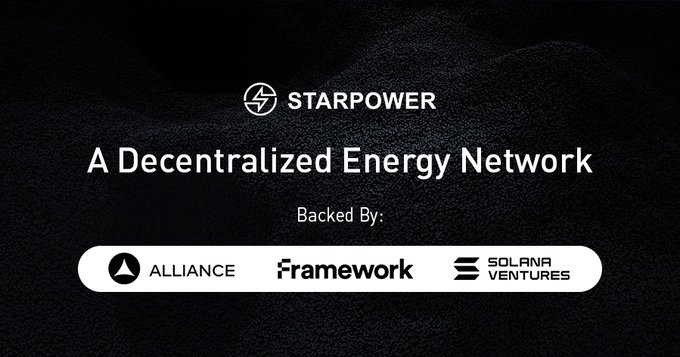
Starpower targets the growth curve of “AI × energy,” aiming to aggregate distributed energy devices—household appliances, storage, and EVs—into an orchestrable DePIN network that supplies virtual power plant (VPP) and demand-response scenarios. Publicly, the team promotes it as a leading energy DePIN in the Solana ecosystem, serving a user base in the millions. This Innovation and Tech article analyzes Starpower’s technical architecture, $STAR utilities, ecosystem and financing progress, and evaluates risk-control essentials.
Summary: Starpower uses a three-layer stack—“device network + AI scheduling + on-chain settlement”—to absorb AI power demand growth; $STAR is used for incentives and service settlement; on the ecosystem side, it has raised funding led by Framework Ventures and is advancing device and platform integrations.
Project Overview: Starpower’s Positioning
Starpower builds an energy DePIN on Solana, treating appliances/batteries/EVs as “orchestrable nodes.” Through its app, it aggregates discrete consumption/storage behaviors into sellable power services (e.g., frequency regulation and peak shaving). Compared with traditional IoT platforms, Starpower emphasizes verifiable on-chain settlement and externally auditable metrics.
What problem does it solve?
The volatility of renewables combined with peak loads from AI compute clusters forces the grid to need more “edge flexibility.” By organizing “household micro-loads/storage” into VPPs, Starpower helps the grid balance peaks and valleys and uses tokenized incentives to shape behavior.
How do users participate?
Everyday users can connect smart plugs, home storage, or EV chargers in the app and authorize “when/how to dispatch” by scenario and thresholds. The network settles incentives automatically in the background. Public information also shows integrations with Apple/Google Home.
Technical Architecture: Device Network & VPP Coordination
Starpower’s approach has three layers: device access (AC, water heaters, EVs, home batteries), AI scheduling (load/price forecasting, optimal charge–discharge/on–off), and on-chain settlement (incentive and fee clearing).
Device Access & Data Layer
Devices onboard via gateways or native SDKs, uploading power, state of charge, temperature/comfort parameters, etc. The platform sets each device’s “transferable load,” forming a callable flexibility pool (Flex Pool). This step determines Starpower’s real power capacity and usable windows.
Scheduling & AI Optimization
The scheduling layer uses load/price forecasts and constraint solving to output a “target curve” per device. The goal is to aggregate a grid-friendly curve without compromising user comfort (e.g., off-peak charging, valley storage, peak discharge) and map revenue to node contribution.
Settlement & On-Chain Components
After a dispatch event completes, the chain records “verifiable calls and contribution values,” which drive $STAR or stablecoin distribution. This allows flexibility to be financialized, recomposed, and interfaced with broader DeFi/RWA contexts. Public materials state the GitBook describes a buyback-and-burn route funded by revenue.
Tokenomics: $STAR Utilities & Disclosure Status
$STAR is a functional network token used mainly for: (i) paying incentives for device output or energy-saving behavior; (ii) acting as a settlement medium/note for VPP services; (iii) community governance and ecosystem incentive budgeting (subject to governance).
Supply & Allocation: Not Fully Disclosed
As of 2025-09-05, Starpower has not fully disclosed $STAR’s total supply and allocations. Some third-party research has claimed “10 billion total” or other figures, which are inconsistent—defer to future official disclosures. Practical assessment should hinge on four core variables: inflation rate, unlock cadence, duration of ecosystem incentives, and the strength of buyback/burn.
Usage & Burn Mechanism
GitBook outlines using “service revenue/device & licensing income to buy back and burn $STAR,” aiming to offset issuance pressure from incentives with real cash flow. The keys are whether buybacks have verifiable cadence, frequency, caps, and transparency.

Ecosystem Partnerships & Data
Starpower claims “1M+ users served and $2M+ cumulative revenue.” Early media and platform posts also reported device-side users surpassing 100k and connections with mainstream home platforms, indicating conversion from “wallet registrations” to “device activations” is progressing.
Partners & Integrations
Public info indicates protocol-level integrations with hardware and platform partners (e.g., home platforms, selected storage/plug vendors). On the Web3 side, it uses Solana ecosystem tools and explorers for project display and data aggregation to aid external review.
Recent Progress & Roadmap
On financing, The Block reported that on 2025-01-09 Starpower closed a new $2.5M round led by Framework Ventures, bringing total funding to about $4M, with Solana Ventures and Bitscale Capital participating. Funds focus on scaling device onboarding and networked dispatch.
Priorities for the Next 6–12 Months
Focus on three things:
- Device scale (activated devices, active hours).
- Dispatch effectiveness (incentive/revenue per kWh, peak–valley reduction).
- On-chain closure (settlement frequency, buyback/burn, and treasury transparency).
These metrics will directly shape Starpower’s cash flow and valuation anchors.
Risks & Compliance
- Technology & operations: forecasting errors, device communications, and vendor ecosystem differences may cause dispatch failures or user-experience variability; under extreme market/weather conditions, failed dispatch increases compensation pressure.
- Market & credit: if service-side revenue is unstable, $STAR buybacks/burns may not offset incentive issuance, raising net token supply pressure.
- Compliance & regional limits: power retail/aggregator licenses, demand-response subsidies, and data compliance vary by jurisdiction; obtain local permits and practice data minimization.
These risks merit added attention amid AI-driven power trends; industry researchers and government reports likewise warn that the “two-way impact of AI and energy systems” requires governance and infrastructure upgrades.
FAQ
How is Starpower different from traditional home-energy apps?
A: Starpower standardizes “transferable load” after device onboarding, and completes auditable settlement via on-chain records and tokenized incentives—making entry into VPP/demand-response markets feasible.
Why are there conflicting statements about $STAR supply and allocation?
A: Starpower hasn’t released a final Tokenomics document, so third-party studies differ. Defer to official docs/contracts and watch unlock and buyback cadence disclosures.
Where do everyday-user earnings come from?
A: Mainly VPP/demand-response service fees and platform incentive budgets; in some regions, power-market subsidies may stack. Pricing rules depend on the local electricity market.
Will devices or comfort be forcibly sacrificed?
A: Dispatch is constrained by user-set thresholds and schedules, typically prioritizing “off-peak/valley-first” strategies to avoid critical disruption. Users can adjust authorization parameters anytime.
Why choose Solana?
A: Low fees and high throughput fit mass micro-settlement and device event recording; the ecosystem already hosts multiple DePIN projects, aiding collaboration and user acquisition.
Key Takeaways
Starpower uses a “device network—AI scheduling—on-chain settlement” stack to meet AI power needs and grid flexibility, positioning itself as an energy DePIN.
$STAR is used for incentives and service settlement with a buyback–burn design; total supply and allocations are not fully disclosed—watch for official updates.
Funding led by Framework Ventures; near-term focus is on device scale and a commercialized dispatch–settlement loop.





